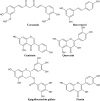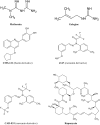Using Drosophila as a platform for drug discovery from natural products in Parkinson's disease
- PMID: 31303984
- PMCID: PMC6596131
- DOI: 10.1039/c9md00099b
Using Drosophila as a platform for drug discovery from natural products in Parkinson's disease
Abstract
Parkinson's disease (PD) is a progressive neurodegenerative movement disorder with no cure. Despite intensive research, most of the currently available therapies are only effective in alleviating symptoms with no effect on disease progression. There is an urgent need for new therapeutics to impede disease progression. Natural products are valuable sources of bioactive compounds that can be exploited for novel therapeutic potential in PD pathogenesis. However, rapid screening of plant-derived natural products and characterization of bioactive compounds is costly and challenging. Drosophila melanogaster, commonly known as the fruit fly, has recently emerged as an excellent model for human neurodegenerative diseases, including PD. The high degree of conserved molecular pathways with mammalian models make Drosophila PD models an inexpensive solution to preliminary phases of target validation in the drug discovery pipeline. The present review provides an overview of drug discovery from natural extracts using Drosophila as a screening platform to evaluate the therapeutic potential of phytochemicals against PD.
Figures






Similar articles
-
Exploring the Efficient Natural Products for the Therapy of Parkinson's Disease via Drosophila Melanogaster (Fruit Fly) Models.Curr Drug Targets. 2024;25(2):77-93. doi: 10.2174/0113894501281402231218071641. Curr Drug Targets. 2024. PMID: 38213160 Review.
-
Using Drosophila melanogaster as a suitable platform for drug discovery from natural products in inflammatory bowel disease.Front Pharmacol. 2022 Dec 5;13:1072715. doi: 10.3389/fphar.2022.1072715. eCollection 2022. Front Pharmacol. 2022. PMID: 36545307 Free PMC article. Review.
-
Neuroprotective effects of compounds with antioxidant and anti-inflammatory properties in a Drosophila model of Parkinson's disease.BMC Neurosci. 2009 Sep 1;10:109. doi: 10.1186/1471-2202-10-109. BMC Neurosci. 2009. PMID: 19723328 Free PMC article.
-
Plant Extracts and Phytochemicals Targeting α-Synuclein Aggregation in Parkinson's Disease Models.Front Pharmacol. 2019 Mar 19;9:1555. doi: 10.3389/fphar.2018.01555. eCollection 2018. Front Pharmacol. 2019. PMID: 30941047 Free PMC article. Review.
-
Non-mammalian animal models of Parkinson's disease for drug discovery.Expert Opin Drug Discov. 2010 Feb;5(2):165-76. doi: 10.1517/17460440903527675. Epub 2010 Jan 5. Expert Opin Drug Discov. 2010. PMID: 22822916
Cited by
-
Inhibition of kinase IKKβ suppresses cellular abnormalities induced by the human papillomavirus oncoprotein HPV 18E6.Sci Rep. 2021 Jan 13;11(1):1111. doi: 10.1038/s41598-020-80193-5. Sci Rep. 2021. PMID: 33441820 Free PMC article.
-
Antioxidant Therapy in Parkinson's Disease: Insights from Drosophila melanogaster.Antioxidants (Basel). 2020 Jan 7;9(1):52. doi: 10.3390/antiox9010052. Antioxidants (Basel). 2020. PMID: 31936094 Free PMC article. Review.
-
Anti-aging and immunomodulatory role of caffeine in Drosophila larvae.Narra J. 2024 Aug;4(2):e818. doi: 10.52225/narra.v4i2.818. Epub 2024 Jun 28. Narra J. 2024. PMID: 39280322 Free PMC article.
-
Drug discovery from natural products - Old problems and novel solutions for the treatment of neurodegenerative diseases.J Pharm Biomed Anal. 2022 Feb 20;210:114553. doi: 10.1016/j.jpba.2021.114553. Epub 2021 Dec 24. J Pharm Biomed Anal. 2022. PMID: 34968995 Free PMC article. Review.
-
Mechanisms of Aging and the Preventive Effects of Resveratrol on Age-Related Diseases.Molecules. 2020 Oct 12;25(20):4649. doi: 10.3390/molecules25204649. Molecules. 2020. PMID: 33053864 Free PMC article. Review.
References
-
- Poewe W., Seppi K., Tanner C. M., Halliday G. M., Brundin P., Volkmann J., Schrag A. E., Lang A. E. Nat. Rev. Dis. Primers. 2017;3:17013. - PubMed
-
- Shulman J. M., De Jager P. L., Feany M. B. Annu. Rev. Phytopathol. 2011;6:193–222. - PubMed
-
- Dorsey E., Bloem B. JAMA Neurol. 2018;75:9–10. - PubMed
-
- Dorsey E., Constantinescu R., Thompson J., Biglan K., Holloway R., Kieburtz K., Marshall F., Ravina B., Schifitto G., Siderowf A., Tanner C. Neurology. 2007;68:384–386. - PubMed
Publication types
LinkOut - more resources
Full Text Sources
Molecular Biology Databases

